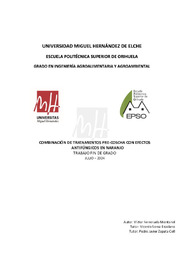Por favor, use este identificador para citar o enlazar este ítem:
https://hdl.handle.net/11000/33087Registro completo de metadatos
| Campo DC | Valor | Lengua/Idioma |
|---|---|---|
| dc.contributor.advisor | Serna Escolano, Vicente | - |
| dc.contributor.advisor | Zapata Coll, Pedro Javier | - |
| dc.contributor.author | Ferreruela Montanel, Víctor | - |
| dc.contributor.other | Departamentos de la UMH::Tecnología Agroalimentaria | es_ES |
| dc.date.accessioned | 2024-09-13T08:27:31Z | - |
| dc.date.available | 2024-09-13T08:27:31Z | - |
| dc.date.created | 2024-07 | - |
| dc.identifier.uri | https://hdl.handle.net/11000/33087 | - |
| dc.description.abstract | La naranja es de entre los cultivos cítricos el más demandado y consumido a nivel mundial. Sin embargo, las podredumbres relacionadas con la acción de hongos fitopatógenos en este cultivo suponen una de las principales pérdidas económicas en las cadenas de suministro. En la actualidad, el control de dichas podredumbres se realiza con fungicidas de síntesis . Sin los consumidores demandan alternativas sin residuos respetuosas con la salud humana y medio ambiente. Por lo tanto, el objetivo del trabajo fue conocer el efecto de los tratamientos pre pre-cosecha con silicato potásico (SP) y bicarbonato sódico (BS) en naranjas ‘NavelNavel’ en el momento de la recolección y tras 42 días de almacenamiento refrigerado. En el momento de la recolección, la firmeza fue mayor en los frutos tratados con SP 0,1 % y 1 %, observado el peor resultado en los frutos tratados con BS 1 % y siendo iguales en los frutos control y los tratados con BS 0,1 %. Respecto al índice de color de cítricos (ICC) los frutos control fueron los que mayor valor mostraron. Además, no se observaron diferencias significativas en el índice de madurez (IM). T ras 42 días de almacenamiento refrigerado, los frutos tratados con BS 1 % tuvieron mayores pérdidas de peso y menor firmeza que el resto, lo que se relacionó con una mayor tasa de respiración. Respecto a al contenido en fenoles totales y actividad antioxidante total en la piel los frutos tratados con BS 1 % y SP 1 % tuvieron menor concentración que el resto durante todo el ensayo ensayo. La incidencia de podredumbres se controló de forma más efectivo en los frutos tratados con BS 1 % y SP 1 %. Por lo tanto, los tratamientos con BS y SP podrían ser una alternativa efectiva para el control de la las podredumbres en post post-cosecha. | es_ES |
| dc.description.abstract | Globally, orange is among citrus crops the most demanded and consumed. Although, disease caused by fungus cause important economic losses in the supply chain. Currently, disease control is carried out with synthetic fungicides. However, consumers demand alternatives without residues and that are healthily and environmentally friendly. Therefore, the aim of this study, is to grasp the effect of pre-harvest treatments of potassium silicate (SP) and sodium bicarbonate (BS) on ‘Navel’ oranges at harvest and after 42 days of chilled storage. After harvest, firmness was higher on fruits treated with SP 0,1 % and 1%, while the worst result was on fruit treated with BS 0,1 % and beins BS 0,1% and control equal. Regarding the citrus colour index (ICC), control fruits scored the highest values. In addition, there were no significant differences in maturity index (IM). After 42 days of chilled storage, fruits treated with BS 1% had higher weight loss and lower firmness, what was correlated with higher respiration rates. Regarding the phenolic total content and total antioxidant activity on the rind at harvest, fruits treated with BS 1% and SP 1% had lower concentration than other treatments. These differences were sustained after chilled storage. Finally, disease levels were higher in fruits treated with BS 0,1 % and SP 1 %. Therefore, treatments with BS and SP are an effective alternative for post-hravest disease control. | es_ES |
| dc.format | application/pdf | es_ES |
| dc.format.extent | 61 | es_ES |
| dc.language.iso | spa | es_ES |
| dc.publisher | Universidad Miguel Hernández de Elche | es_ES |
| dc.rights | info:eu-repo/semantics/openAccess | es_ES |
| dc.rights.uri | http://creativecommons.org/licenses/by-nc-nd/4.0/ | * |
| dc.subject | post-cosecha | es_ES |
| dc.subject | cítricos | es_ES |
| dc.subject | naranjo | es_ES |
| dc.subject | pre-cosecha | es_ES |
| dc.subject | vida útil | es_ES |
| dc.subject | post-harvest | es_ES |
| dc.subject | Citrus | es_ES |
| dc.subject | orange | es_ES |
| dc.subject | pre-harvest | es_ES |
| dc.subject | shelf-life | es_ES |
| dc.subject.other | CDU::6 - Ciencias aplicadas::63 - Agricultura. Silvicultura. Zootecnia. Caza. Pesca::633 - Cultivos y producciones | es_ES |
| dc.title | Combinación de tratamientos pre-cosecha con efectos antifúngicos en naranjo | es_ES |
| dc.title.alternative | Combination of pre-harvest treatments with antifungical effects on orange trees | es_ES |
| dc.type | info:eu-repo/semantics/bachelorThesis | es_ES |

Ver/Abrir:
Ferreruela_TFG.pdf
8,27 MB
Adobe PDF
Compartir:
 La licencia se describe como: Atribución-NonComercial-NoDerivada 4.0 Internacional.
La licencia se describe como: Atribución-NonComercial-NoDerivada 4.0 Internacional.
.png)